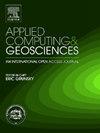Pore-to-Darcy scale permeability upscaling for media with dynamic pore structure using graph theory
Abstract
Permeability is a key rock property important for scientific applications that require simulation of fluid flow. Although permeability is determined using core flooding experiments, recent advancements in micro-CT imaging and pore scale fluid flow simulations have made it possible to constrain permeability honoring pore scale rock structure. Previous studies have reported that complex association of pores and solid grains often results in preferential flow paths which influence the resulting velocity field and, hence, the upscaled permeability value. Additionally, the pore structure may change due to geochemical processes such as microbial growth, mineral precipitation and dissolution. This could result in a flow field which dynamically evolves spatially and temporally. It would require numerous experiments or full physics simulations to determine the resultant upscaled Darcy permeability for such dynamically changing systems. This study presents a graph theory-based approach to upscale permeability from pore-to-Darcy scale for changing pore structure. The method involves transforming a given micro-CT rock image to a graph network map followed by the identification of the least resistance path between the inlet and the outlet faces using Dijkstra's algorithm where resistance is quantified as a function of pore sizes. The least resistance path is equivalent to the path of lowest resistance within the domain. The method was tested on micro-CT images of the samples of Sherwood Sandstone, Ketton Limestone and Estaillades Limestone. The three micro-CT images were used to generate 30 synthetic scenarios for geochemically induced pore structure changes covering a range of pore and solid grain growth. The least resistance value obtained from Dijkstra's algorithm was observed to correlate with upscaled permeability value determined from full physics simulations, while improving computational efficiency by a factor of 250. This provides confidence in using graph theory method as a proxy for full physics simulations for determining effective permeability for samples with changing pore structure.

 求助内容:
求助内容: 应助结果提醒方式:
应助结果提醒方式:


